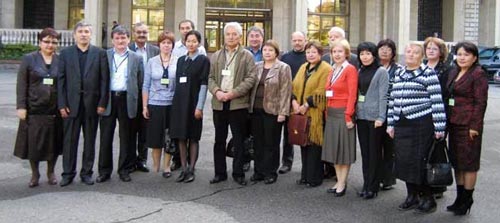Launched in 2010 by the National Center for Biotechnology of the Republic of Kazakhstan, JSC “KazAgroInnovation”, FAO, and CIMMYT, the “Strengthening the Plant Biotechnology Capacity for Sustainable Utilization of Plant Genetic Resources for Food and Agriculture in Kazakhstan” initiative gained further momentum when CIMMYT organized a training seminar on “Modern Plant Genetic Resources: Conservation, Characterization, and Use Methods” during 24-28 October 2011 in Almaty, Kazakhstan.
In his welcome address, Muratbek Karabayev (CIMMYT-Kazakhstan) focused on the mobilization of genetic plant resources, and the role of biotechnology and breeding in the preservation and management of genetic resources, agriculture, and food production. Karabayev stressed that success can only be achieved through mutually beneficial cooperation between plant breeders and biotechnologists, and that partnerships should have a common purpose and trust between collaborators, with proper funding to assist research at the highest international standards.
Olga Mitrofanova, Head of the Wheat Genetic Resources Department, N.I. Vavilov Institute of Plant Industry (VIR), presented on the role of plant genetic resources in crop breeding, and the contribution of VIR to this science, such as the agroecological classification of cereals by sub- regions according to climatic conditions and varieties. This is particularly important in countries as large as Kazakhstan as regional factors need to be considered when drafting and implementing development strategies for biotechnology, plant genetic resources, and breeding.
Other speakers included Sergej Martynov, Key Researcher, VIR, and Elena Salina, Cytology and Genetics Institute, who delivered lectures on the genetic diversity and evolution of domestic and wild wheat species, and the various approaches of analyzing plant genetic resources.

Seminar participants agreed that the use of biotechnology in crop production should be assessed based on the breeding efficiency of new varieties. At the national level, activities should involve a wide range of stakeholders to efficiently preserve and use plant genetic resources in the long-term. The key priorities are that disease-free seeds should be preserved in-situ and ex-situ, with duplication in other seed banks, as well as appropriate regeneration and replenishment of collections. The contents of collections should be properly characterized and documented by well-qualified staff. Communication with other collections is also vital for identifying and obtaining new seed sources, and for subsequent distribution and utilization of germplasm.
As mentioned in the Informa issue 1767, many Kazakhstani scientists also feel it is necessary to establish a National Bank of Genetics Resources in Kazakhstan, and to develop a National Strategy on the conservation of plant genetic resources and their use in food and agriculture.

